Scientific name: Oenothera cespitosa Nutt.
Synonym: Oenothera caespitosa (*synonym epithet is spelled differently – more info in article. We use the accepted name according to this reference).
Suggested pronunciation: ee-no-THEE-ruh kess-pi-TOH-suh
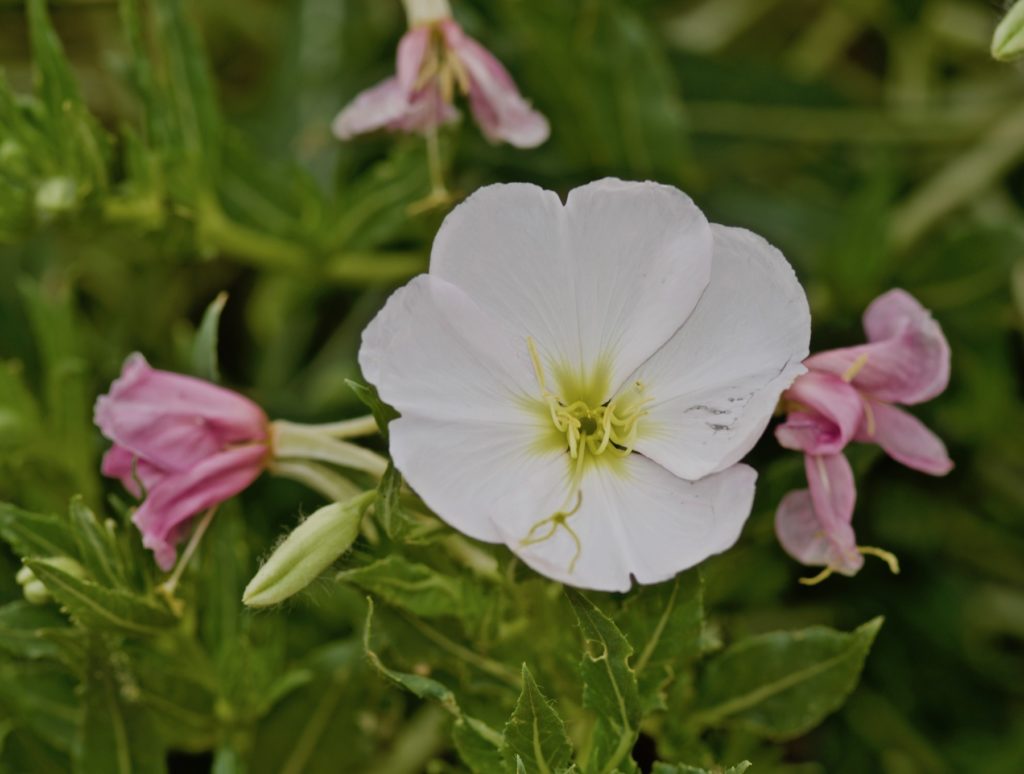
Photo by Janice Tucker
Common names: tufted evening primrose, desert evening primrose, gumbo evening primrose, gumbo lily, fragrant evening primrose
Family: Onagraceae (evening primrose)
Suggested pronunciation: on-uh-GRAY-see-ee
Article by Janice Tucker. Photos by Janice Tucker, Patrick Alexander, Karduelis (Wikipedia public domain)
Those of us who have the good fortune to live in Santa Fe, New Mexico, often choose to dine al fresco on a summer’s evening, taking advantage of the normally pleasant nighttime temperatures. Filling a garden near an outdoor living area with night-blooming flowers such as the tufted evening primrose (Oenothera cespitosa) will enhance the ambiance of dining beneath the stars with fragrance and floral beauty. But do not be totally fooled by the “evening” in evening primrose. The Oenothera cespitosa’s white flowers open just before sunset and remain in full bloom throughout the night. However, they normally stay open until the early afternoon the following day before becoming a recent memory as they shrink to a rosy pink.
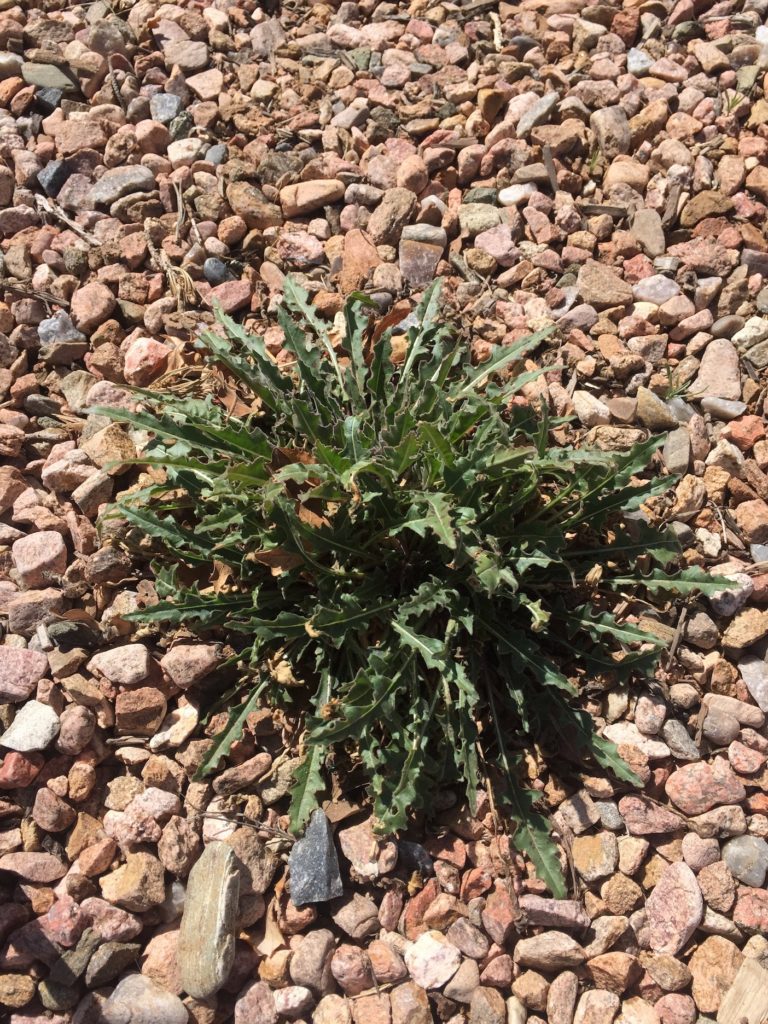
Tufted evening primrose leaves and growth habit. Photo: Janice Tucker
The Oenothera cespitosa covers a large area of North America where it is native to the western United States, the Canadian provinces of Alberta, Saskatchewan and Manitoba, and the Baja region of northern Mexico. It has also been successfully introduced to the northeastern United States. Rhizomes that extend from a strong taproot establish colonies in open fields, along roadsides, railway embankments and in areas with disturbed soil.
It thrives in altitudes of 3,000 to 7,5000 feet and braves environments of low annual rainfall, hot summers and cold winters. Like many wildflowers that can prove their mettle with the challenges that nature throws at them, the tufted evening primrose has become a welcome addition to home gardens. It is considered a short-lived perennial. But keep in mind that plants have a strong survival instinct. Therefore, even as one plant dies back there will most likely be another nearby due to the combination of prolific seed production and rhizomes to facilitate its continued existence.
Hairy, elliptical leaves extend directly from a tufted (hairy) basal rosette, maturing to a low, attractive plant of 8 to 12 inches high with a spread of about 2 feet. White, four-petaled flowers that open in the evening and turn pink as they close the following day peek out from the leaves. The mature plant with its arrangement of long, green, serrated leaves liberally scattered with white and pink flowers resembles a large bouquet rooted to the ground.
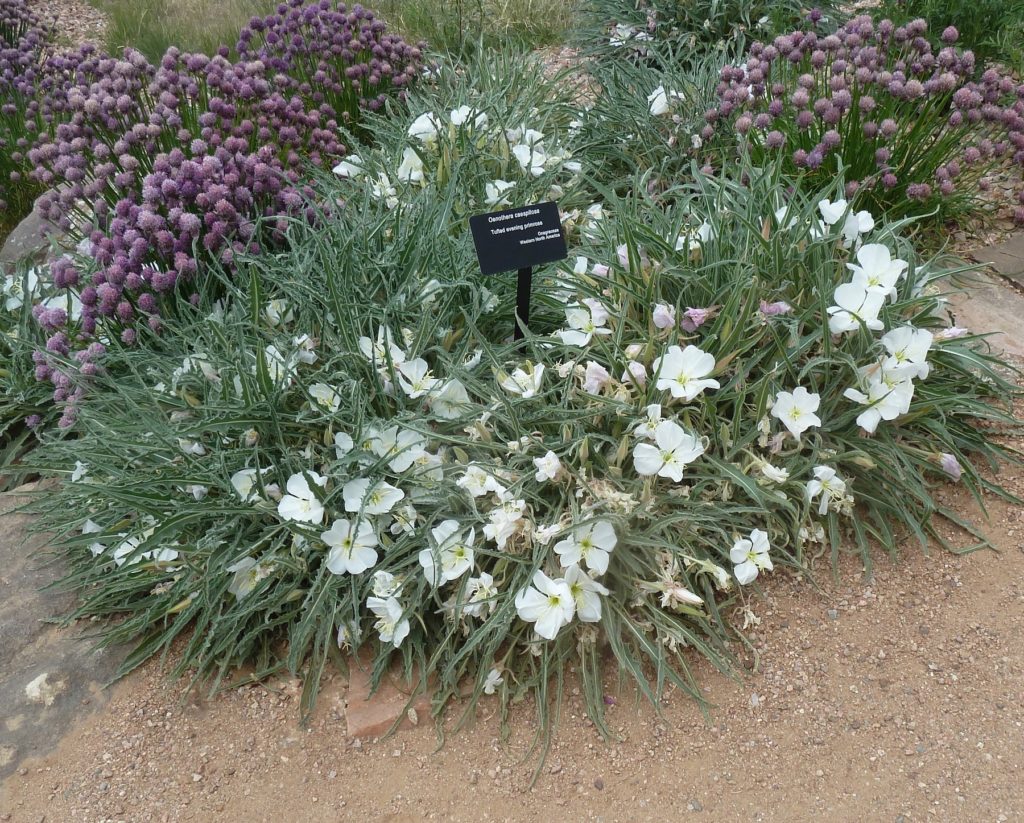
Oenothera caespitosa (tufted evening primrose) in Ojos y Manos garden. Photo: Janice Tucker
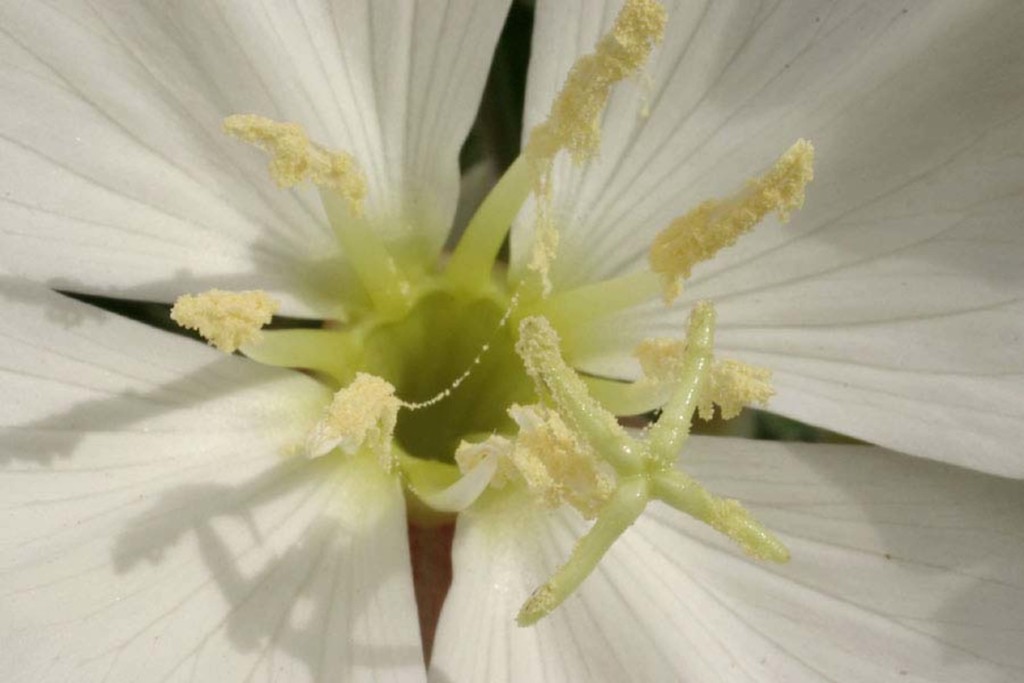
Oenothera caespitosa stigma close up. Photo: Patrick Alexander
The flower has a deep throat that extends to the base of the plant (hypanthium). This structure is especially beneficial to long-tongued night pollinators such as hawk moths and vespertine (nocturnal) bees and long-beaked daytime feeders such as hummingbirds. Insects and other pollinators with shorter probosces are out of luck with this flower since they are not physically equipped to reach the nectar. Like all species of the Oenothera genus, its distinctive cross-shaped stigma extends beyond the stamens. The sweet fragrance and light color lure pollinators to sip the nectar held in the flower’s throat. Upon exiting they brush by pollen-laden stamens. The collected pollen is deposited onto the stigma of the next flower they visit. Spent flowers will eventually produce seed-packed capsules that form clumps at the base of the plant. Birds eat the seeds, which promotes propagation.
It is always a pleasure to find native, flowering plants that are suitable for gardens in Santa Fe’s USDA Zone 6b. The tufted evening primrose is such a plant that gives back more than it asks of those who tend to them. Plant it in a sunny or semi-shaded location in well-drained soil. Its low growth makes a beautiful border along paths and the edges of patios. It gives a finishing touch when placed in front of taller shrubs or beneath trees. Very little supplemental moisture is needed but a deep watering every 10 days in the summer will not go amiss. Monthly winter watering will keep it hydrated during the cold weather. Maintenance is minimal. It blooms from spring into late summer and is compatible with neighboring plants.Those who live in areas where wildlife tends to pay uninvited nighttime visits to gardens will be glad to know it is deer-resistant. However, be aware if you live in an area where Japanese beetles are a problem. Unfortunately, they love evening primroses. To see a preview before planting, visit the Santa Fe Botanical Garden at Museum Hill in Santa Fe, New Mexico. The tufted evening primrose is located in the Arroyo east and west beds as well as in the Pavilion Planting Area (center steps and east beds).
Getting to know a plant should include learning a bit about its history and name. In researching the genus Oenothera, the definition and comments made by Al Schneider, who gives us the excellent Southwest Colorado Wildflowers website, explains it best – with a twist of humor – when citing naming credit to Swedish botanist, Carl Linnaeus (1707-1778): “Linnaeus named this genus in 1753 using a name given several thousand years ago by Theophrastus to another genus in this family. The meaning of “Oenothera” is not agreed on; Greek gives us both “oenos” for “wine” and “thera” which is variously translated as “to seek”, “to imbibe”, “to catch”, “to hunt”. “Thera” could indicate that the plant (really just the root) was used to flavor wine, or the root was used to absorb wine and was then fed to animals to calm them, or the juice of the root was put in wine to seduce, or the root in wine just plain made people happy.”
The generic species can either be spelled “cespitosa” or “caespitosa”. They are pronounced the same and both mean “tufted”, which refers to the basal tuft of leaves. Perhaps there was a misspelling somewhere in its history and now taxonomists cannot agree on which is correct. This also explains the reason that tufted evening primrose is one of the common names. In 1811 while on the Astor Expedition, English botanist, Thomas Nuttall (1786-1859), discovered the Oenothera cespitosa along the Missouri River in South Dakota. He is credited with naming it in 1813.
The following story – found in several variations – explains how the Oenothera genus ended up with the common name of evening primrose: In the 1600’s, English botanist John Goodyer (1592-1664) was describing a species of the Oenothera that grew in what is now the eastern United States. The plant’s fragrance reminded the botanist of Europe’s wild primroses. So he gave the plant the common name of evening primrose. And here we are centuries later still using it since no one ever seems to bother with changing or correcting common plant names.
One other fact regarding the vernacular, evening primrose, that many may know but some may not. The evening primrose is sometimes mistakenly identified as a primrose or a rose. The evening primrose is totally unrelated to the primrose, and neither is related to the rose. Scientifically, the evening primrose is the common name for the Oenothera genus in the Onagraceae (evening primrose) family. The primrose is the common name for the Primula genus in the Primulaceae (primrose) family. The rose is the common name for the Rosa genus in the Rosaceae (rose) family. There are no rules regarding common plant names and while they are often charming they can also be misleading. The evening primrose, the primrose and the many varieties of roses are all lovely and each should be appreciated for their individual characteristics.
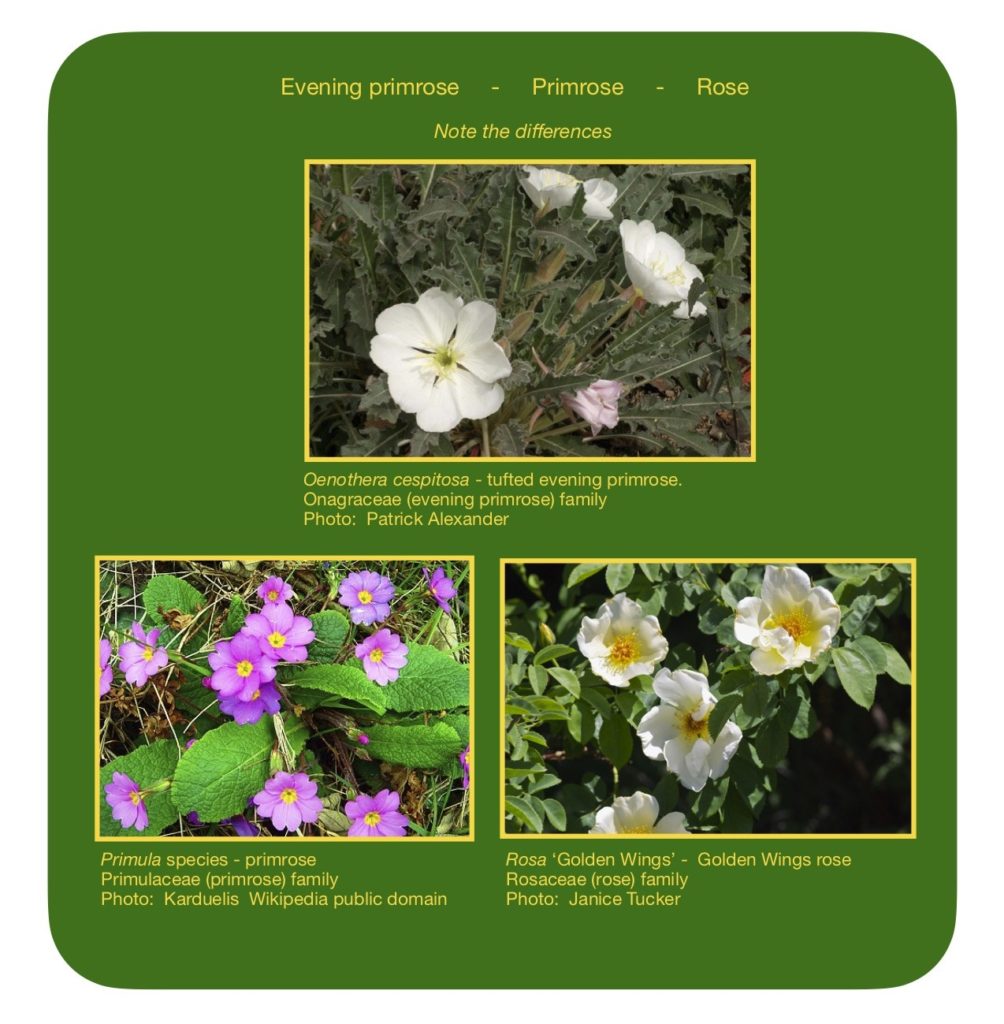
The evening primrose’s charm is captured in the following poem by the English poet, John Clare (1793-1864). However, since the flowers usually do not fade until around mid-day, we may have a slight disagreement with the phrase, “Wastes its fair bloom upon the night”.
Evening Primrose
by John Clare
“When once the sun sinks in the west,
And dewdrops pearl the evening’s breast;
Almost as pale as moonbeams are,
Or its companionable star,
The evening primrose opes anew
Its delicate blossoms to the dew;
And, hermit-like, shunning the light,
Wastes its fair bloom upon the night,
Who, blindfold to its fond caresses,
Knows not the beauty it possesses;
Thus it blooms on while night is by;
When day looks out with open eye,
Bashed at the gaze it cannot shun,
It faints and withers and is gone.”
– – – – – – – – – – – – – – – — – – – – – – – –
Thanks to Helen Woody and Jeanne Gozigian for proofreading this article.
Sources Consulted and/or Cited
Alexander, Patrick.“Oenothera caespitosa subsp.caespitosa”. New Mexico Flora -Images of plants from New Mexico and other parts of southwestern North America. Web. 2020. Accessed 20 Aug 2020. Retrieved from: http://polyploid.net/swplants/index.html
Clare, John.“Evening Primrose John Clare, English (1793-1864) Poems of John Clare”. Friends of the Wild Flower Garden. Web. 2014. Accessed 16 Aug 2020. Retrieved from: https://www.friendsofthewildflowergarden.org/pages/archive/poems/poem2014_44.html.
McDonald, Charlie. “Plant of the Week Tufted evening -primrose (Oenothera caespitosa)”. USDA, NRCS. 2020. The PLANTS Database (http://plants.usda.gov, 10 August 2020). National Plant Data Team, Greensboro, NC 27401-4901 USA. https://plants.usda.gov/java/citePlants. Accessed10 Aug 2020. Retrieved from: https://www.fs.fed.us/wildflowers/plant-of-the-week/oenothera_caespitosa.shtml.
“John Goodyer”. Wikipedia. Web.14 Mar 2020. Accessed 28 Aug 2020. Retrieved from: https://en.wikipedia.org/wiki/John_Goodyer.
“Onagraceae”. Wikipedia. Web. 24 Apr 2020. Accessed 15 Jul 2020. Retrieved from: https://en.wikipedia.org/wiki/Onagraceae.
“Oenothera”. Wikipedia. Web. 24 Jun 2020. Accessed 15 Aug 2020. Retrieved from: https://en.wikipedia.org/wiki/Oenothera.
“Oenothera caespitosa Nutt.” Native Information Network. Lady Bird Johnson Wildflower Center. Web. 21 Feb. 2009. Accessed 15 Jul 2020. Retrieved from: https://www.wildflower.org/plants/result.php?id_plant=OECA10.
“Oenothera caespitosa. Tufted Evening Primrose”. Southwest Desert Flora. Web. 12 Oct 2017. Accessed 15 Jul 2020. Retrieved from: http://southwestdesertflora.com/WebsiteFolders/All_Species/Onagraceae/Oenothera%20caespitosa,%20Tufted%20Evening%20Primrose.html.
“Oenothera caespitosa (tufted evening primrose)”. USDA, NRCS. 2020. The PLANTS Database (http://plants.usda.gov, 10 August 2020). National Plant Data Team, Greensboro, NC 27401-4901 USA.
“Oenothera cespitosa”. Garden Explorer. Santa Fe Botanical Garden.Web.15 Jul 2020. Accessed 10 Aug 2020. Retrieved from: https://santafebotanicalgarden.gardenexplorer.org/taxon-520.aspx.
“Oenothera cespitosa Nutt. (tufted evening primrose”. SEINet – Arizona-New Mexico Chapter. http//:swbiodiversity.org/index.php. Web. 2020. Accessed 15 Jul 2020. Retrieved from: http://swbiodiversity.org/seinet/taxa/index.php?taxon=Oenothera+caespitosa&formsubmit=Search+Terms
“Oenothera cespitosa Nutt”. USDA, Agricultural Research Service, National Plant Germplasm System. 2020. Germplasm Resources Information Network (GRIN-Taxonomy). National Germplasm Resources Laboratory, Beltsville, Maryland. Accessed 16 Aug 2020. Retrieved from: https://npgsweb.ars-grin.gov/gringlobal/taxonomydetail.aspx?id=310176. Accessed 16 August 2020.
Schneider, Al. “Oenothera caespitosa subspecies marginata (Tufted Evening Primrose)”. Southwest Colorado Wildflowers. Web. 15 Jul 2020. Accessed 15 Jul 2020. Retrieved from: https://www.swcoloradowildflowers.com/White%20Enlarged%20Photo%20Pages/oenothera%20white.htm.
“Thomas Nuttall”. Wikipedia. Web. 13 Aug. 2020. Accessed 28 Aug. 2020. Retrieved from: https://en.wikipedia.org/wiki/Thomas_Nuttall.


